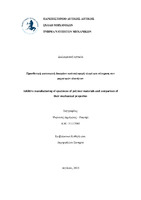| dc.contributor.advisor | Δημητρέλλου, Σωτηρία | |
| dc.contributor.author | Ψαριανός, Δημήτριος-Ραφαήλ | |
| dc.date.accessioned | 2023-07-28T07:46:17Z | |
| dc.date.available | 2023-07-28T07:46:17Z | |
| dc.date.issued | 2023-07-26 | |
| dc.identifier.uri | https://polynoe.lib.uniwa.gr/xmlui/handle/11400/4894 | |
| dc.identifier.uri | http://dx.doi.org/10.26265/polynoe-4732 | |
| dc.description.abstract | Η τρισδιάστατη εκτύπωση αποτελεί μια τεχνολογία η οποία αναπτύσσεται ραγδαία τα
τελευταία χρόνια με συνεχείς βελτιώσεις αναφορικά με την ταχύτητα, την ποιότητα
αλλά και την ευκολία εκτύπωσης αντικειμένων. Εξ αιτίας των χαρακτηριστικών αυτών
αλλά και των συγχρόνων τρισδιάστατων εκτυπωτών που έχουν τη δυνατότητα
εκτύπωσης διαφόρων υλικών όπως μέταλλα, πλαστικά, σύνθετα, πολλές βιομηχανίες
και εταιρίες επιθυμούν την ενσωμάτωση της συγκεκριμένης τεχνολογίας στα τωρινά ή
στα μελλοντικά βραχυπρόθεσμα επιχειρηματικά τους σχέδια. Η τρισδιάστατη
εκτύπωση έχει ένα ευρύ φάσμα εφαρμογών σχεδόν σε όλες τις βιομηχανίες και
παρουσιάζει σημαντικές δυνατότητες ανάπτυξης, μελέτης και έρευνας.
Σκοπός της παρούσας διπλωματικής εργασίας είναι η τρισδιάστατη εκτύπωση
δοκιμίων από τα υλικά PLA, PC, και PAHT CF15, και η μελέτη της συμπεριφοράς
τους και των μηχανικών ιδιοτήτων τους μέσω πειραματικών δοκιμών.
Στο πρώτο κεφάλαιο γίνεται μια ιστορική αναδρομή στην τρισδιάστατη εκτύπωση και
στο δεύτερο κεφάλαιο παρουσιάζονται οι διάφορες τεχνολογίες προσθετικής
κατασκευής. Το τρίτο κεφάλαιο περιλαμβάνει τον τρισδιάστατο σχεδιασμό των
δοκιμίων εφελκυσμού, κάμψης, ερπυσμού και κρούσης με το λογισμικό Fusion360,
την περιγραφή των υλικών που θα χρησιμοποιηθούν στην εργασία, και την
προσομοίωση της εκτύπωσης μέσω του λογισμικού Cura. Στο τέταρτο κεφάλαιο
περιγράφεται αναλυτικά η διαδικασία της εκτύπωσης για όλα τα δοκίμια, αναφέρονται
τα προβλήματα που προέκυψαν και η επίλυσή τους, και υπολογίζεται η
διαστασιολογική σταθερότητα των εκτυπωμένων δοκιμίων. Στο πέμπτο κεφάλαιο
παρουσιάζονται οι πειραματικές δοκιμές εφελκυσμού, κάμψης τριών σημείων,
ερπυσμού και κρούσης, ενώ πραγματοποιείται σκληρομέτρηση, μέτρηση πυκνότητας
και οπτική μικροσκοπία. Τα αποτελέσματα των δοκιμών καταγράφονται αναλυτικά και
συγκρίνονται οι ιδιότητες των υλικών. | el |
| dc.format.extent | 91 | el |
| dc.language.iso | el | el |
| dc.publisher | Πανεπιστήμιο Δυτικής Αττικής | el |
| dc.rights | Αναφορά Δημιουργού - Μη Εμπορική Χρήση - Παρόμοια Διανομή 4.0 Διεθνές | * |
| dc.rights | Attribution-NonCommercial-NoDerivatives 4.0 Διεθνές | * |
| dc.rights | Attribution-NonCommercial-NoDerivatives 4.0 Διεθνές | * |
| dc.rights.uri | http://creativecommons.org/licenses/by-nc-nd/4.0/ | * |
| dc.subject | Τρισδιάστατη εκτύπωση | el |
| dc.subject | Προσθετική κατασκευή | el |
| dc.subject | FDM | el |
| dc.subject | PLA | el |
| dc.subject | PC | el |
| dc.subject | PAHT CF15 | el |
| dc.subject | Εφελκυσμός | el |
| dc.subject | Ερπυσμός | el |
| dc.subject | Κρούση | el |
| dc.subject | Σκληρομέτρηση | el |
| dc.title | Προσθετική κατασκευή δοκιμίων από πολυμερή υλικά και σύγκριση των μηχανικών ιδιοτήτων | el |
| dc.title.alternative | Additive manufacturing of specimens of polymer materials and comparison of their mechanical properties | el |
| dc.type | Διπλωματική εργασία | el |
| dc.contributor.committee | Ιακωβίδης, Ισίδωρος | |
| dc.contributor.committee | Pagonis, Dimitris Nikos | |
| dc.contributor.faculty | Σχολή Μηχανικών | el |
| dc.contributor.department | Τμήμα Ναυπηγών Μηχανικών | el |
| dc.description.abstracttranslated | 3D printing is a technology that has evolved rapidly in recent years with continuous
improvements in terms of speed, quality, and ease of printing objects. Due to these
characteristics and the capabilities of modern 3D printers that print a variety of
materials such as metals, plastics, and composites, many industries and companies are
considering integrating this technology in their current or future short-term business
plans. 3D printing has a wide range of applications in almost all industries and offers a
significant potential for development, study, and research.
The purpose of this thesis is the 3D printing of samples from PLA, PC, and PAHT CF15
materials, and the study of their behavior and mechanical properties through
experimental tests.
In the first chapter the historical review of 3D printing is presented and in the second
chapter the various technologies of prosthetic manufacturing are described. The third
chapter includes the 3D design of the tensile, bending, creep and impact samples with
the Fusion360 software, the description of the materials used in the work, and the
simulation of the printing process through the Cura software. In the fourth chapter, the
printing process for all the samples is described in detail, the problems that arose and
their solutions are mentioned, and the dimensional stability of the printed samples is
calculated. In the fifth chapter, the tensile, three-point bending, creep, and impact
experimental tests are presented, as well as hardness measurement, density
measurement and optical microscopy are performed. The results of the tests are
presented in detail and the properties of the materials are compared. | el |


